

Melting ice puts emperor penguins on a slippery slope - life - 29 June 2014. Antarctica's iconic emperor penguins are predicted to go into decline this century.
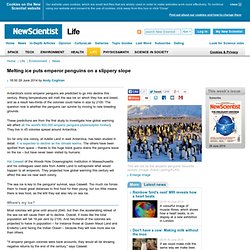
Rising temperatures will melt the sea ice on which they live and breed, and as a result two-thirds of the colonies could halve in size by 2100. The question now is whether the penguins can survive by moving to new breeding grounds. These predictions are from the first study to investigate how global warming will affect all the world's 600,000 emperor penguins (Aptenodytes forsteri). Butterflies and birds unable to keep pace with climate change in Europe. Butterflies and birds are no longer able to keep up with climate change.
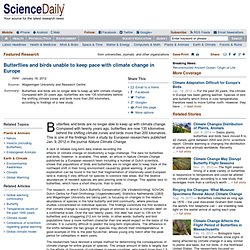
Compared with twenty years ago, butterflies are now 135 kilometres behind the shifting climate zones and birds more than 200 kilometres. This is one of the findings from a study by European researchers published Jan. 9, 2012 in the journal Nature Climate Change. Surprise species at risk from climate change. Most species at greatest risk from climate change are not currently conservation priorities, according to an International Union for Conservation of Nature (IUCN) study that has introduced a pioneering method to assess the vulnerability of species to climate change.

The paper, published in the journal PLOS ONE, is one of the biggest studies of its kind, assessing all of the world's birds, amphibians and corals. World-first hybrid shark found off Australia. Scientists said on Tuesday that they had discovered the world's first hybrid sharks in Australian waters, a potential sign the predators were adapting to cope with climate change.
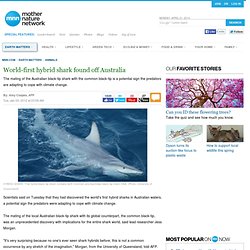
The mating of the local Australian black-tip shark with its global counterpart, the common black-tip, was an unprecedented discovery with implications for the entire shark world, said lead researcher Jess Morgan. Does Climate Change Mean More Polar-Grizzly Bear Hybrids? It's been a rough half-million years for the polar bear, so it sure doesn't help that man-made climate change is driving them toward extinction.
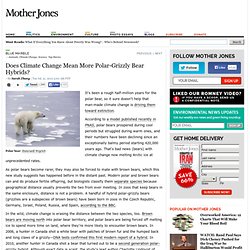
According to a model published recently in PNAS, polar bears prospered during cool periods but struggled during warm ones, and their numbers have been declining since an exceptionally balmy period starting 420,000 years ago. That's bad news (bears) with climate change now melting Arctic ice at unprecedented rates. As polar bears become rarer, they may also be forced to mate with brown bears, which this new study suggests has happened before in the distant past. Modern polar and brown bears can and do produce fertile offspring, but biologists classify them separate species because geographical distance usually prevents the two from ever meeting. Effects of climate change on birds worsened by housing development. Although climate change may alter the distributions of many species, changes in land use may compound these effects.

Now, a new study by PRBO Conservation Science (PRBO) researcher Dennis Jongsomjit and colleagues suggests that the effects of future housing development may be as great or greater than those of climate change for many bird species. In fact, some species projected to expand their distributions with climate change may actually lose ground when future development is brought into the picture. The study, "Between a rock and a hard place: The impacts of climate change and housing development on breeding birds in California," appears online in the journal Landscape Ecology. Conservationists have long known that changing land use and development may pose a major threat to wildlife through habitat loss and degradation. Yet, many recent studies have focused solely on how the changing climate will impact species. Climate change may alter conditions for growth of oak trees in Basque woodlands.
Penguins are dying because of climate change, claim scientists. Birds in Argentina and Antarctica are dying from shifts in weatherMany chicks die from extremes of temperature and rainfallIn some years, climate change was biggest cause of death By Sam Webb Published: 22:04 GMT, 29 January 2014 | Updated: 22:19 GMT, 29 January 2014.
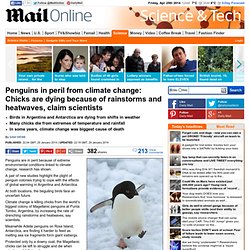
Science Says: Climate Change Stress Is Crippling Our Forests. Half of the planet’s animals, birds, and insects make their homes in forests, which cover 30 percent of our blue-green planet.
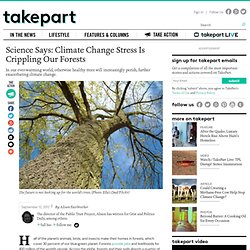
Forests provide jobs and livelihoods for 400 million of the world’s people. Across the globe, forests and their soils absorb a quarter of all manmade carbon emissions. But climate change is altering all of that. Forests are increasingly susceptible to drought and heat-stress, and scientists have been recording massive tree die-offs due to the warming of the planet—a phenomenon that will only become more frequent. Forest razing by ancient Maya worsened droughts, says study. (Phys.org) -- For six centuries, the ancient Maya flourished, with more than a hundred city-states scattered across what is now southern Mexico and northern Central America.

Then, in A.D. 695, the collapse of several cities in present day Guatemala marked the start of the Classic Maya's slow decline. Prolonged drought is thought to have played a role, but a study published this week in the journal Geophysical Research Letters adds a new twist: The Maya may have made the droughts worse by clearing away forests for cities and crops, making a naturally drying climate drier. "We're not saying deforestation explains the entire drought, but it does explain a substantial portion of the overall drying that is thought to have occurred," said the study's lead author Benjamin Cook, a climate modeler at Columbia University's Lamont-Doherty Earth Observatory and the NASA Goddard Institute for Space Studies.
The Maya also lacked the technology to tap the groundwater several hundred feet beneath them. Painted turtles set to become all-female - life - 03 May 2013. Males don't stand a chance in a warmer world, if they happen to be painted turtles.
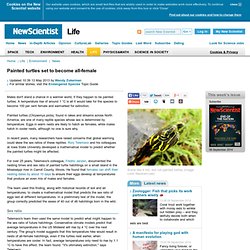
A temperature rise of around 1 °C is all it would take for the species to become 100 per cent female and earmarked for extinction. Painted turtles (Chrysemys picta), found in lakes and streams across North America, are one of many reptile species whose sex is determined by temperature. Eggs in warm nests are likely to hatch as females, while males hatch in cooler nests, although no one is sure why.
In recent years, many researchers have raised concerns that global warming could skew the sex ratios of these reptiles. Rory Telemeco and his colleagues at Iowa State University developed a mathematical model to predict whether the painted turtles might be affected. For over 25 years, Telemeco's colleague, Fredric Janzen, documented the nesting times and sex ratio of painted turtle hatchlings on a small island in the Mississippi river in Carroll County, Illinois.
Sex ratio. Did climate change turn all dinosaurs male? Could the enduring mystery of why the dinosaurs died out come down to how sex was determined in the group of animals. Credit: Peter Shouten SYDNEY: Why the dinosaurs died out 65 million years ago may come down to how the sex of their offspring was determined, said American palaeontologists and microbiologists.